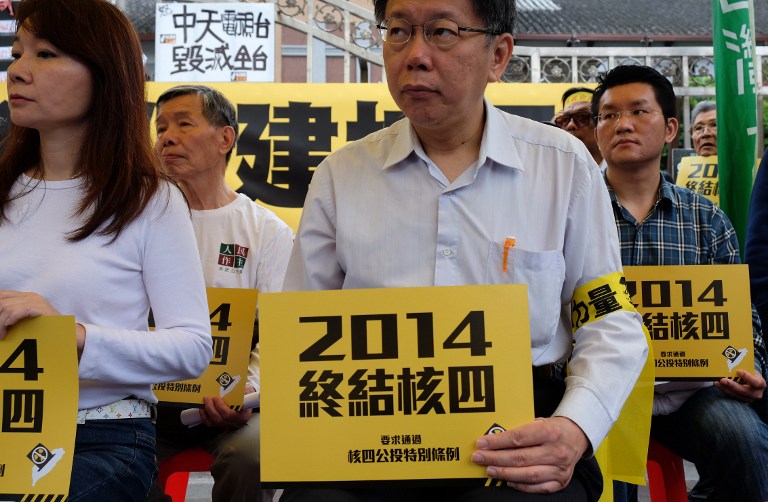As Taiwan becomes embroiled in nuclear energy debates, pro-nuclear and anti-nuclear activists are becoming focused on alternative energy solutions and energy saving benefits. Taiwan could cut 45% of energy consumption by simply overhauling current luminaires with LEDs, resulting in lower power consumption and redistribute energy resources, according to a joint study by TrendForce research divisions LEDinside and EnergyTrend. Considerable energy can be conserved from the lighting sector’s transformation alone, based on the research organization’s analysis of LED lights energy efficiency benefits, international market experience, and related statistics in Taiwan.
 |
|
Anti-nuclear protesters display placards reading "terminate the fourth nuclear power plant in 2014" outside Parliament during a demonstration in Taipei on April 22, 2014. Former Taiwanese opposition leader and anti-nuclear activist Lin Yi-hsiung launched an indefinite hunger strike in protest of a nearly completed nuclear facility, while some of his supporters clashed with police. (AFP PHOTO / Sam Yeh) |
Energy conserved from LED lighting solutions can transform Taiwan’s energy reliance
Taiwan’s lighting sector energy consumption reached about 22 billion kWh in 2013. Around 11.9 billion kWh or a 45% energy consumption reduction is achievable if the country’s commercial, industrial and residential lighting sectors all converted to LEDs. The 10 billion kWh of electricity conserved would be equivalent to 24% of the 41.6 billion kWh electricity generated by the country’s three nuclear power plants in 2013. Pragmatically, it is impossible for all lighting in Taiwan to be retrofitted with LEDs at the moment. However, solely increasing the proportion of LED lighting could diminish the country’s reliance on nuclear energy.
 |
|
A company employee introduces a LED light during a building materials fair at the World trade Center in Taipei on November 16, 2012. (AFP PHOTO/ Sam Yeh) |
The most common luminaires found in Taiwan’s lighting market include conventional incandescent bulbs, halogen lamps, high pressure sodium lights and metal halides. In recent years, LED technology has taken off resulting in maturing product quality and prices. LED components especially have reached luminous efficacy of 130 to 140 lm/W, while LED luminaires have reached above 100 lm/W. If more energy efficient LED luminaires are applied in residential, industrial, commercial and public lighting (including landscape lighting and streetlights), the energy benefits could create a healthier energy structure. TrendForce projects global LED bulb demands will increase 86% YoY in 2014, while LED tube light demands growth rates are expected to reach 89%.
 |
|
A policeman stands guard at the island's third nuclear power plant during a safety drill in the southern Pingtung county on September 10, 2013. (AFP PHOTO/ Sam Yeh) |
In terms of energy structure, Taiwan’s nuclear plants are still base power plants, while solar energy remains as a peaker because of technical and environmental limitations. Photovoltaics (PV) can only become a load following power plant in countries with mature application environments. At current stage, it is still difficult for PV to replace nuclear energy. The Taiwan market is currently focused on whether power plants reserve capacity and nuclear energy ratio is too high.
In reality, Taiwan’s renewable energy including solar and wind energy can only be used as backup energy or share some loading from current power plants. However, the country’s green energy industry investments and developments should still be encouraged. For future energy options, Taiwan should pay more attention to biofuel, geothermal energy and other renewable energies.
 |
|
Taiwan still has a long way to go before PV can replace nuclear energy. This photo depicts solar panels installed on the roof of the Future Pavilion at the Taipei International Flora Exposition in Taipei during a preview on October 13, 2010. (AFP PHOTO/PATRICK LIN) |
Lower overall energy consumption by taking advantage of energy savings from lighting
Taiwan should actively develop LED lighting subsidies and industry promotional projects, said TrendForce. Based on market value calculations, the island country’s LED lighting penetration rate is about 22%, which in the short term should be raised to 50%. Aside from conventional and LED streetlight sectors, international energy saving targets should also be applied in factories, offices, and commercial lighting applications. Only by doing so can Taiwan’s energy saving benefits become truly effective.















